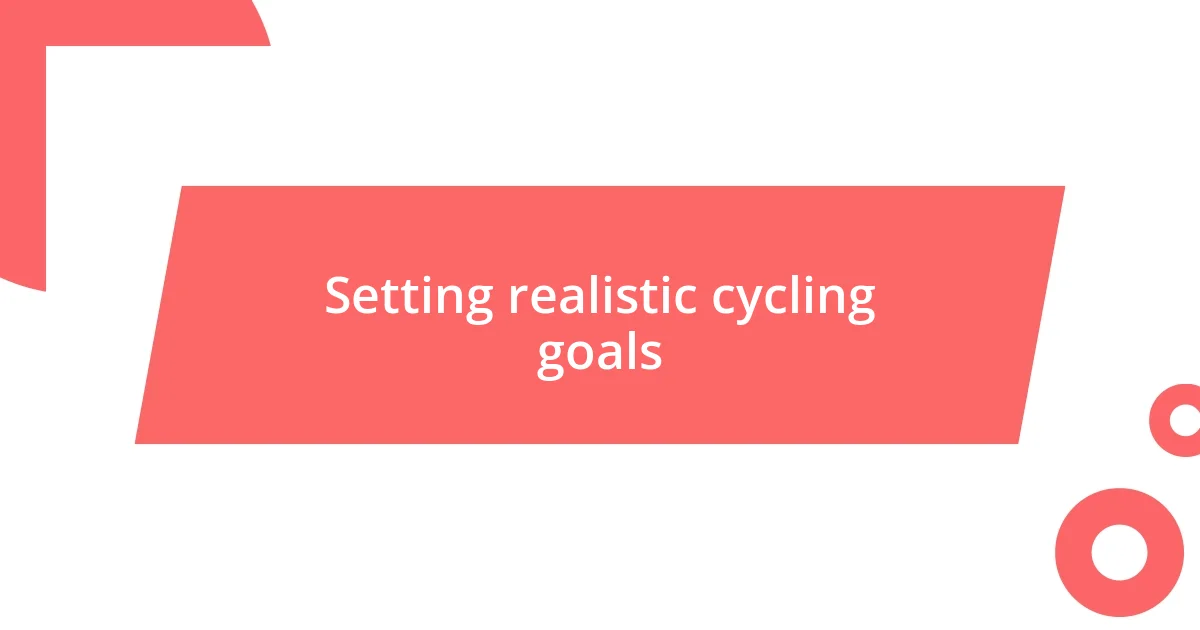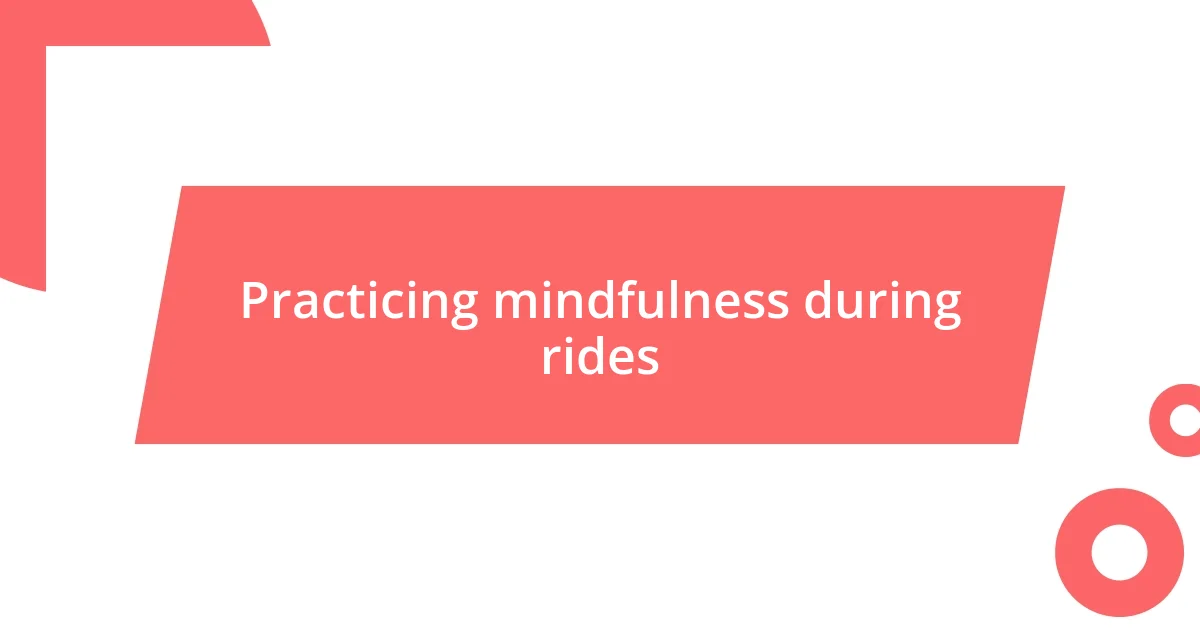Key takeaways:
- Identifying and addressing specific cycling fears, such as losing control and fear of judgment, allows for personal growth and reinforces confidence.
- Setting realistic, flexible goals and celebrating small victories helps maintain motivation and adapt to challenges, making progress feel achievable.
- Joining a supportive cycling community fosters encouragement and empathy, making it easier to confront and overcome personal fears together.

Understanding my cycling fears
Understanding my cycling fears has been a journey of self-reflection. I vividly remember my first solo ride, the wind whipping past my face but with every sound of a car approaching, my heart raced. Was I too close to the road? Would I fall? That day, I realized that my apprehensions stemmed not just from biking itself but from the vulnerability I felt in such an exposed state.
One fear that consistently haunted me was the idea of losing control. I can still recall an instance when I took a sharp turn too quickly and nearly veered off the path. The adrenaline surged, and I thought, “What if I wasn’t able to react in time next time?” This moment taught me that acknowledging my fears was crucial; it was about transforming those fears into learning opportunities rather than letting them paralyze me.
I often find myself grappling with the fear of judgment too. Have you ever hesitated to ride in public because you worried about how you’d look? I have! The thought of being watched, critiqued, or even ridiculed can be overwhelming. But then, I started to realize that everyone has their insecurities, and this shared experience somehow bridged a connection with fellow cyclists rather than creating distance. Understanding my fears helped me reshape my mindset around cycling, shifting from dread to curiosity.

Identifying fear triggers while cycling
As I delved deeper into cycling, I began to pinpoint the specific situations that triggered my fears. Some of these were surprisingly subtle, like the rumble of gravel under my tires, which instantly sent shivers down my spine. Each time I encountered this terrain, my mind flashed back to a particularly rocky descent that rattled my confidence. By identifying these triggers, I started to approach rides with a more prepared mindset, ready to confront these challenges head-on instead of allowing them to paralyze me.
To better understand my fear triggers, I created a list that highlighted key situations that caused discomfort. This simple practice opened my eyes to my patterns and reactions:
- Riding near busy roads, where cars raced by too closely
- Encountering steep hills that made me doubt my stamina
- Sudden weather changes, like unexpected rain or strong winds
- Navigating through crowded areas, where people are milling about
- Seeing steep drop-offs or unstable paths that made me second-guess my skills
By breaking down these fears, I found that each encounter was an opportunity to reflect and grow. Each ride became less about the fear and more about mastering my reactions, ultimately boosting my confidence in the saddle.

Setting realistic cycling goals
Setting realistic cycling goals is essential for overcoming fear on the bike. I remember when I set my first goal to ride five miles without stopping. It seemed daunting at first, but breaking it down into manageable segments—like two miles to the nearby park—made it feel achievable. When I finally reached that park, I felt a surge of accomplishment that motivated me to push my limits further.
As I progressed, I learned that flexibility in my goals was key. Initially, I would get disheartened by bad weather or unexpected challenges, but I found that adapting my goals helped me stay positive. For instance, when it rained one day, I switched to an indoor cycling session. I not only maintained my routine but also discovered new workouts I enjoyed. This taught me that goals should evolve with my circumstances, allowing for growth without the pressure of perfection.
One of the most profound insights I gained was from celebrating small victories. After reaching a popular cycling spot nearby, I rewarded myself with a small treat—a ritual I found delightful. These small celebrations reminded me that every step I took counted, no matter how small, and built a solid foundation for tackling bigger goals down the road.
| Goal Type | Description |
|---|---|
| Short-term Goals | Focus on immediate, achievable targets like completing a 10-mile ride. |
| Long-term Goals | These are more ambitious, such as preparing for a charity ride or cycling a full century. |
| Flexible Goals | Adjust goals based on conditions, like swapping outdoor rides for indoor sessions during bad weather. |
| Celebratory Goals | Incorporate small rewards for completing tasks, enhancing motivation along the way. |

Practicing mindfulness during rides
The moment I began practicing mindfulness during my rides, everything changed. Instead of racing thoughts about potential dangers, I focused on my breath and the rhythm of my pedaling. I remember one ride particularly well; as I paused at a scenic overlook, I took a deep breath, felt the cool breeze, and listened to the sound of leaves rustling. This simple act helped me stay grounded and present, transforming fear into a moment of tranquility.
I often ask myself, “What do I notice around me?” It’s amazing how tuning into the details—the vibrancy of the flowers, the warmth of the sun, or even the texture of the road beneath my tires—can shift my focus. During a challenging ascent, I felt the initial panic rising, but then I redirected my energy. I embraced each challenge as a stepping stone, reminding myself that this ride was mine to claim, fear and all.
Incorporating mindfulness has also taught me that it’s okay to slow down. In the past, I would power through difficult sections, fearing that stopping would only invite anxiety. However, I now cherish moments when I can take a break and reflect. During one particularly tough stretch, I stopped, closed my eyes for a moment, and allowed myself to feel gratitude for my body’s strength. That small shift in perspective not only eased my fears but also deepened my connection to my cycling journey. It’s a comforting reminder that every ride can be an opportunity for discovery, if only we let ourselves be present.

Building confidence with small steps
Every journey starts with a single step, and that applies beautifully to building confidence on the bike. I remember the first time I challenged myself to ride just around my block. It felt significant, almost monumental, to navigate those small turns and gentle inclines. With each lap, I gradually became acquainted with my surroundings, which sparked excitement instead of fear. Can you recall your own small wins that turned into big accomplishments?
As I ventured beyond my neighborhood, I began to set tiny targets—a five-minute ride became ten, then fifteen. I intentionally chose routes that were familiar but slightly challenging, like weaving through a nearby park. Each small victory not only strengthened my physical abilities but also boosted my belief in myself. There were times I’d feel that nagging doubt creeping in, thinking, “What if I can’t make it this time?” But I learned to counter that with a simple mantra: “Start small, finish strong.”
In those early days, even my fears became manageable when I connected them with small, actionable steps. When faced with a steep hill that made my heart race nervously, I’d remind myself to breathe, pedal steadily, and focus on just getting to the next tree or lamp post. I can still feel the exhilaration of reaching the top, knowing that each small effort was laying the groundwork for greater confidence. Transformation is often hidden in these little moments, don’t you think?

Joining a supportive cycling community
Being part of a supportive cycling community has been a game-changer for me. I remember nervously attending my first group ride, unsure of what to expect. As I joined my fellow cyclists at the starting line, I felt a wave of encouragement wash over me—everyone was there with the same passion for cycling. That collective energy helped to dissolve my fears, making me realize I wasn’t alone in my journey.
The camaraderie I found in that group made tackling challenges feel less daunting. On one particularly daunting ride, I was struggling to climb a steep hill while others were effortlessly gliding past. Instead of feeling embarrassed, a seasoned cyclist took the time to ride alongside me. “Just focus on your breathing,” she said, and her reassurance made all the difference. It’s those small moments of connection that remind me how powerful community can be.
When I see others overcoming their own fears, it truly inspires me. There’s a shared understanding and empathy among cyclists that’s hard to find elsewhere. Have you ever felt uplifted just by watching someone else push through their limits? I often do, and it motivates me to do the same. The supportive environment fosters growth and resilience, proving that we all have what it takes to ride through our fears together.

Celebrating progress and milestones
Absolutely, celebrating progress and milestones is such an integral part of tackling fears. I distinctly recall the thrill of reaching a new distance; it was like a light bulb flicked on in my mind. One Saturday, I decided to bike 15 miles for the first time. When I zoomed back into my driveway, I was practically buzzing with excitement! It wasn’t just about the mileage; it was a tangible reminder that I was moving forward, overcoming each fear one pedal stroke at a time. Have you experienced a moment where you felt on top of the world for conquering something you once thought was impossible?
Looking back, I’ll always cherish those small celebrations after each ride. Even something as simple as treating myself to a favorite snack became part of my ritual. I remember stopping at a cafe on my way home after a successful group ride that pushed my limits. Sipping a cold drink, I felt immensely proud and connected to my journey. Isn’t it fascinating how those little rewards can reinforce our accomplishments? They not only celebrate the milestones but also become motivation for future rides.
I’ve learned that documenting these moments transforms an experience into cherished memories. I started keeping a cycling journal, listing out each milestone—big and small. The day I recorded my first 20-mile ride, I felt a wave of satisfaction wash over me. Each tick mark in that journal tells a story of perseverance, reminding me of where I started and how far I’ve come. Doesn’t it feel wonderful to have a tangible reminder of your growth? It’s these records of triumphs that can light the path ahead when fears threaten to creep back in.















